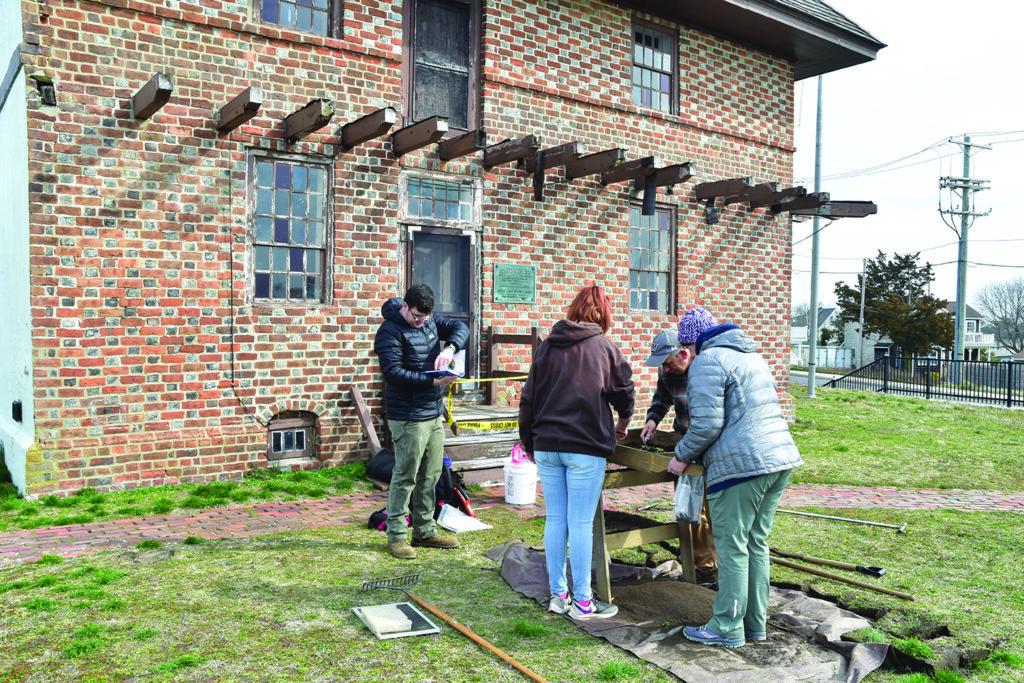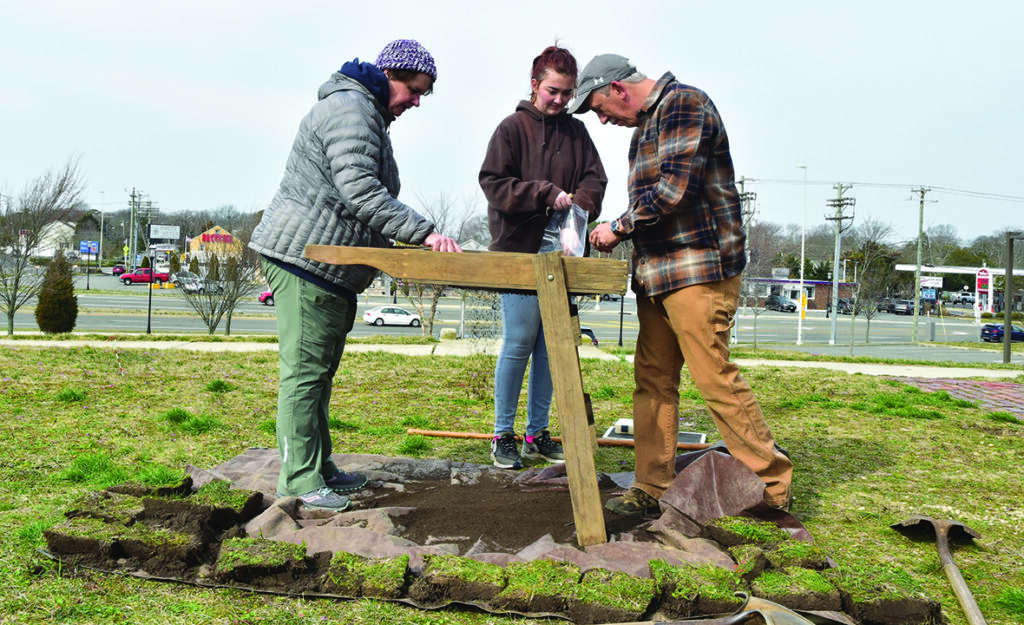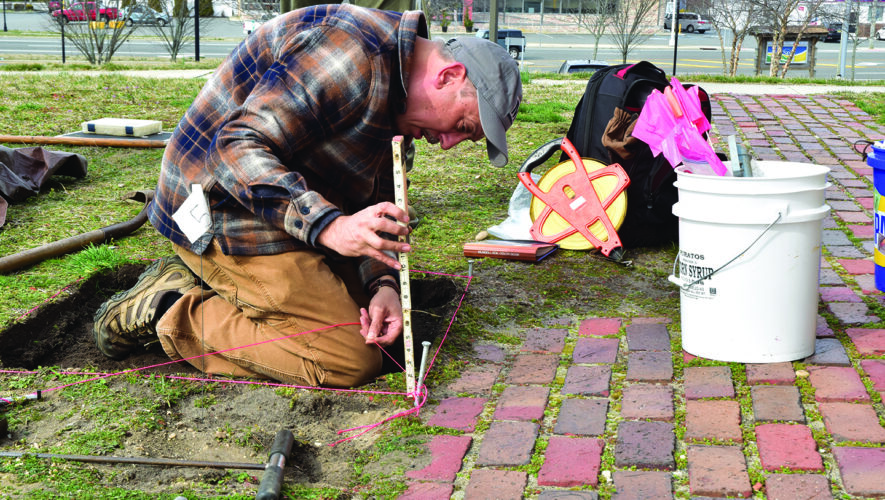Excavation finds Colonial items, Lenape pottery, stone tool tied to long Native American trade routes
SOMERS POINT — A team of archaeologists from University of Monmouth is uncovering the past — shovelful by shovelful — on the grounds of the historic Somers Mansion.
Rich Veit, a professional historical archaeologist and president-elect of the national Society for Historical Archaeology, said the work should shed some light on the interaction between the Lenni Lenape, who spent summers in the area, and early settlers such as the Somers family.
“It’s fabulous working at a house from the very early 1700s. That initial period of settlement when native Americans and European settlers, quite often Quakers in this area, were interacting, that’s a period that we don’t know enough about,” Veit said.
The Patriots for the Somers Mansion, a nonprofit group dedicated to reviving the original home of the city’s founder and its fantastic grounds, is funding the dig through a grant it received several years ago. Veit, along with his son, Douglas Veit, student Jillian McConville and graduate student Charlene Boehm, started digging March 3 and returned March 17 with plans to continue for several weeks.
Levi Fox, treasurer of the Patriots, said they hope to unearth the early history of the mansion and learn more about the relationship between the two groups.
He said the Patriots are working with two Lenape consultants with different tribes in Oklahoma that are federally recognized as having history that ties them to the area.
Fox said the site was the perfect place for a settlement or homestead.
“We are at a confluence of several roads — Shore Road and Somers Point-Mays Landing Road were native American trails that led up the coast or toward the Philadelphia area. We have every reason to believe that at one point in Somers Point’s history it would have been a meeting point for summer camps that were on the islands,” Fox said.
Academics believe the Lenape were not permanent settlers of the area, but more like tourists who visit only when the weather is pleasant.
“The ways that we use the land, getting together with cousins and eating fresh seafood on the sand, was pretty much how the native Americans used this land. It wasn’t a permanent settlement,” Fox said. “The islands in this area would have been a seasonal location.”
The Lenape were drawn to the region from the Philadelphia and New York areas by its wealth of fish and game as well as by the cooler weather.
“I think it’s a fabulous site. Imagine the landscape without the diner and the bridge — the view is totally spectacular. Even coming up the road to the house, it is sitting up on this high knoll.

“I think this would have been the perfect place to live whether you were a native American or early settler. You could see everything, for miles out to the barrier islands, back to Beesleys Point.
“Given the different environments, here you’re at an upland but you’ve got the bay, you’ve got the ocean. It’s like a Walmart — you’ve got everything you need right here in one place,” Veit said.
Fox said he worked with Veit when he was a graduate student and reconnected after the group received its grant for the work. He said it was an arduous process but eventually bore fruit.
“The fact that we already started to find some objects that potentially show that linkage helps to justify the grant,” Fox said.
Fox said the grant “enabled us to do something we had always wanted to do independently before we ever met.”
Viet said he worked on a major dig at the B.L. England site in Beesleys Point 20 years ago and noticed the mansion.
“Driving back and forth from Beesleys Point to Somers Point, I always would look up here and think ‘that’s really where I want to be,’” Veit said.
New discoveries
Veit said they used a rather crude method of searching, not radar or other technology,
“We laid out a grid of shovel tests on the property. We dug about every 25 feet and where we started finding stuff, we did more,” he said, noting it’s the traditional way and works really well.
The group already has uncovered some artifacts from both cultures.

“In the little bit of work we did two weeks ago, we found a small assemblage of artifacts, a handful of native American artifacts — pottery and stone tools, which is super, super exciting — we had some colonial artifacts as well,” Veit said.
Among the items discovered are a colonial shoe buckle, Lenape potsherd and a stone tool.
He said the east side has seen a lot of disturbance from construction of Shore Road but the front was rich in materials and that deposits on the west side and in the garden bore a mix of early colonial — late 1600s, early 1700s — native American and even Victorian items.
Veit said the potsherds “tend not to survive, they’re very fragile. When we find them it’s a small miracle.”
The items that are unearthed eventually will be displayed after being washed, catalogued and photographed.
“It’s a state park, so all of the artifacts hopefully go to state parks to curate and take care of,” Veit said. “I wouldn’t be surprised if they decide to display some of them here.”
Fox said the ultimate goal is to have the objects displayed at the mansion to help add to the knowledge and bring more interest to the site.
Veit said it is highly unlikely that they would unearth human remains or other items that would generate a larger-scale effort — or stop it completely.
“The dream scenario is to half-accidentally stumble upon some old outbuilding or the original cabin,” Fox said.
“If we were to find the cabin that was on this site before this house, Levi wouldn’t be able to get me off the phone. I would be lobbying him daily to come out and do more work here. That would be a game-changer,” Veit said.
Veit said the stone tool came from the Pocono Mountains area, demonstrating a complex system of trade or long-range seasonal migration. Items discovered in Beesleys Point came from Ohio.
“There was a lot more trade than most people had believed,” he said. “Native American societies were dynamic, complex societies.”
Somers Mansion
Somers Mansion was built at what is now the junction of Shore Road, MacArthur Boulevard/Route 52 and Somers Point-Mays Landing Road, but must have commanded a sweeping, unobstructed view of the bay across unspoiled meadows when city founder Richard Somers built it, which was between 1720 and 1726, according to visitsomerspoint.com.
The mansion remained in the Somers family until 1937 when it was deeded to the Atlantic County Historical Society, according to the site, and was transferred to the state in 1941. The home now is recognized as a State Historic Site and the State Park Service is charged with its upkeep and operation.
Built in the Colonial style, the home later was converted into a Victorian-style structure, according to somersmansionpatriots.org. In the early 1940s, a project of the Works Progress Administration returned it to its classic appearance.
The Patriots hope to offer educational opportunities in the mansion’s annex, where volunteers recently renovated the bathroom that will allow more events to be held there.
Fox said the 300th anniversary of the mansion is coming up in 2025 and the group is hoping to tie into historical events celebrating the 250th anniversary of the founding of the United States.
“This site has a lot of interesting stories to tell about that time period,” Fox said, noting it is the oldest home in Atlantic County.
Hopes are that restoration of the property would spur interest in the city’s other historical offerings along Shore Road. The Atlantic County Historical Society maintains a museum just a stone’s throw away. Farther down the street is the Richard Somers Memorial outside the original City Hall — which is now a branch of the Atlantic County Library System — as well as the Somers Point Historical Society museum just a couple of doors down.
The group is planning a public archaeology day Saturday, May 6, the week after Bayfest, during which members of the public will be able to assist at the dig site.
By CRAIG D. SCHENCK/Sentinel staff



